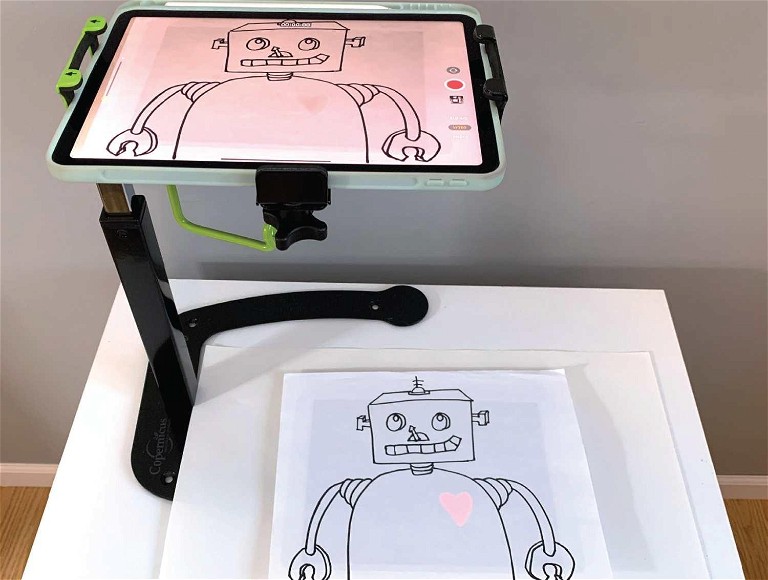EARLY CHILDHOOD
Jessica.
Tricia Fuglestad
This project originated from my desire to develop a lesson for my first-graders that would combine physical drawings and digital animations to amplify student voice, foster creative expression, and incorporate social-emotional learning (SEL) goals.
Students studied the works of 17th-century painter Rembrandt van Rijn and created unique 21st-century “emotional robots” while addressing multiple National Core Arts Standards and the ISTE Creative Communicator Standard. Students also practiced empathy and self-expression and developed a lexicon of feelings.
Starting with a Story
We began by reading the interactive SEL story PETER O’Meter (Teachergoals Publishing, 2023), which features an emotional robot whose feelings are triggered when his buttons are pushed. Readers help PETER identify his emotions by using clues from the illustrations and calibrating his upgraded eMotion panel.
Students scanned a page in the book to access an augmented reality version of PETER, complete with the eMotion panel, music, and colorful overlays. They cycled through the panel to see how PETER’s facial expressions changed with each emotion. This activity introduced the first of three art challenges that would culminate in the creation of a glowing eMotion robot.
This project combines physical drawings and digital animations to amplify student voice, foster creative expression, and incorporate social-emotional learning.
Rembrandt and Facial Expressions
Dutch painter Rembrandt van Rijn (1606–1669) used facial expressions to capture human emotion. I showed students various images of his works and asked them to guess the emotions depicted in each piece. Students closely examined the eyes, eyebrows, and mouth of each subject.
Next, we used mirrors to observe our own faces making similar expressions. This led to a game in which I called out an emotion, and students used their eyes, eyebrows, and mouths to match it. After a few rounds, I asked for a volunteer to display an emotion while the rest of the class guessed the emotion based on the volunteerʼs facial expression.
Emotion Prompts
In the next activity, students sketched eyes, eyebrows, and mouths on paper to match a series of emotion prompts. After sketching, students were invited to take a trip around the room to view their classmates’ interpretations of the prompts, broadening their understanding of how facial expressions can be represented as line drawings.
Gianna.
Sonny.
Chelsea.
Dario.
Robot Drawings
After these investigations, students used plain 8½ x 11" (21.5 x 28 cm) paper to create a black marker line drawing of the head and torso of a robot. I provided them with a variety of robot-shaped heads and torsos as examples and instructed them to leave the torso of their robot blank to allow space for the next stage of this multimedia project.
Symbol Animation
To express the deep emotions inside our robots, we used symbolism in the form of glowing, animated icons. The effect of the symbol animation glowing through the robot’s torso and emerging from beneath the drawn art on the paper reminds us that it’s okay to express our emotions to others.
Students selected a symbol to correspond with the emotion depicted on the face of their robot drawing. We discussed symbols, their connotations, and how they might amplify an emotion. Examples included a star for excitement, a tornado for confusion, and balloons for joy.
After students sketched a simple version of their chosen symbol on a separate sheet of paper, I introduced the concept of flipbook-style animation, where the illusion of movement is created by flipping through a series of still images. For this animation, students were asked to draw their symbol three times in three sizes: large, medium, and small.

Video recording in progress. Students placed their drawings over their glowing iPad symbols to capture the animation.
Once the symbol sketches were finalized, students used the Do Ink animation and drawing app in flipbook mode to create their symbol animation. We selected this app because it allows you to continuously loop the animation over a black background, enhancing the glowing effect and making it easier to capture in the next stage of this lesson.
Communicating Feelings
Talking about feelings helps children develop emotional vocabulary and learn to identify emotions in themselves and others. This lesson gives students an opportunity to practice this skill by recording the animation glowing from their robot drawing while expressing how their robot feels.
Students placed their paper robot drawing over the iPad animation, causing it to continuously glow through the paper. Next, a recording device (such as a phone or iPad) was positioned above to capture the animation. While recording, the student said, “My robot is feeling (insert word to describe the emotion conveyed).”
This short video encapsulates the art, animation, and the artist’s voice expressing emotion in a way Rembrandt couldn’t have imagined. The videos can be shared in a digital portfolio, configured with augmented reality that plays when itʼs scanned. View our collection of first-grade examples in the Resources below.
NATIONAL STANDARD
Producing: Develop and refine artistic techniques and work for presentation.
Tricia Fuglestad is an art teacher at Dryden Elementary School in Arlington Heights, Illinois. fuglefun@gmail.com Glowing eMotion Bots